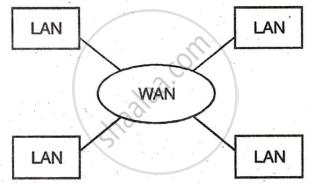Topics
Introduction to Microprocessors and Organization of 8085
Instruction Set and Programming of 8085
Introdcution to Inted X-86 Family
Introduction to Microcontroller
Networking Technology
- Introduction to Networking
- Types of Networks
- Multiplexing
- Study of Transmission media
- Coaxial cable (Cable Media)
- Twisted pair cable
- Fiber Optic Cable
- Unbounded (Wireless) Media
- Access Methods
- Network Topologies
- Ethernet (Network Architectures)
- Token-Ring (Network Architectures)
- Internet protocols
- Introduction to connectivity devices
- Introduction
- Local Area Network (LAN)
- Metropolitan Area Network (MAN)
- Wide Area Network (WAN)
Networks in Communications
A Network is an interconnected system that provides communication links among the two or more stations. Each station in a network is known as node.
WAN (Wide Area Network)
A Wide Area Network (WAN) covers a large geographical area, often spanning entire countries or states. Common examples include the national telephone system, cellular networks, and paging systems. WANs use various communication links such as cables, microwave towers, and satellites, often in combination. Systems like railway and airline reservations are also examples of WANs.
MAN (Metropolitan Area Network)
A Metropolitan Area Network (MAN) is a medium-sized network, larger than a LAN but smaller than a WAN. It typically covers a city, like a cable TV network connecting multiple households to satellite programs. Communication in a MAN is usually via cable and is often one-way. The pager system is another example of a MAN.
LAN (Local Area Network)
A Local Area Network (LAN) is the smallest network, commonly used for computer communications within a 10 km radius. It connects 10 to 1000 PCs, typically within an organization, under a central control system called a server, which may be a minicomputer or mainframe. LANs are often used in environments like college computer labs for efficient communication and resource sharing.
Types of Networks
A Network is an interconnected system that provides communication links between two or more stations. Each station in a network is known as node.
Local Area Network (LAN)
A local area network (LAN) connects computers within a small area, such as a building or campus. Key characteristics include high data transfer rates, limited geographical coverage, and various connection techniques. A LAN typically consists of many PCs controlled by a central server, which can be a minicomputer or a mainframe.
Metropolitan Area Network (MAN)
A Metropolitan Area Network (MAN) is larger than a LAN but smaller than a WAN. An example is a city's cable network, which distributes TV programs from satellites to multiple TV sets via cable. Another example is the pager system.
Wide Area Network (WAN)
A Wide Area Network (WAN) covers a large area and interconnects multiple LANs. WANs can span entire countries or states using cables, microwave towers, satellite links, or a combination. For instance, telephone systems use all three media for communication. Key characteristics of WANs are extensive coverage, slower data transfer compared to LANs, and the use of telephone lines to connect LANs.

